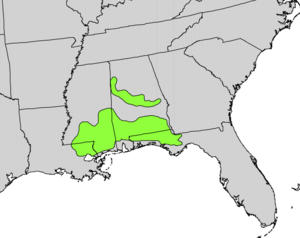Florida anise facts for kids
Quick facts for kids Florida anise |
|
|---|---|
 |
|
| Conservation status | |
| Scientific classification | |
| Genus: |
Illicium
|
| Species: |
floridanum
|
 |
|
| Natural range | |
Illicium floridanum is a special plant known by a few names, like purple anise or Florida anise. Some people even call it the stink-bush because of its smell! It's an evergreen shrub, which means its leaves stay green all year long. You can find this plant growing naturally in the southeastern parts of the United States, especially in Florida and Louisiana.
What it Looks Like
The Florida anise tree has big, shiny, dark green leaves. They are shaped like a spear, which is called "lance-shaped." If you crush a leaf, it gives off a sweet smell, a bit like the spice anise. Each leaf has a main vein that runs straight down the middle, with other veins running parallel to it.
Inside the plant's leaves, a flower grows. This flower has about 20 to 30 petals that are a beautiful maroon color. Each flower is usually about 2 inches (5 cm) wide. Even though the flower is pretty, it can be hard to spot because it's often hidden by the plant's thick, shiny leaves. The flower also has a smell, which some people describe as being like fish.
When the flower is ready, its star-shaped fruit bursts open, sending seeds flying out! Sometimes, you might see Florida anise plants with white flowers. These are usually grown by people who have carefully bred them to have different colors.
How it was Discovered
The Illicium floridanum plant was first found way back in 1765. It was discovered by a helper of a man named William Clifton, Esq., in West Florida. They saw it growing in a swamp near Pensacola.
Then, in 1766, a famous botanist named John Bartram found the same plant. He was the official botanist for King George III of Great Britain. John Bartram found the plant along the St. Johns River in East Florida. He drew pictures of the plant and wrote down details about its petals, leaves, and how it looked as a tree.
Where it Grows
This plant, Illicium floridanum, grows in several places. You can find it in northern Florida and Georgia. It also grows along the coast all the way to Louisiana. In Georgia, this plant species is considered to be endangered, which means there aren't many of them left in the wild.
The Illicium floridanum shrub often grows in wet areas, like swamps or marshes, but it can also be found in drier spots. It likes places that are partly or fully shaded. However, it can grow in sunny areas too, as long as it gets plenty of water. The best soil for this plant is moist and has mulch, especially when the weather is dry.
Important Safety Information
It's very important to know that Illicium floridanum should not be eaten. It is not safe to use as a spice for cooking.
There is another plant, called Illicium verum, which is from China. That plant is used as a spice, and its oil is used in some medicines and to flavor drinks. But remember, Illicium floridanum is different and is not safe to eat.



